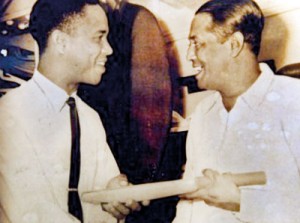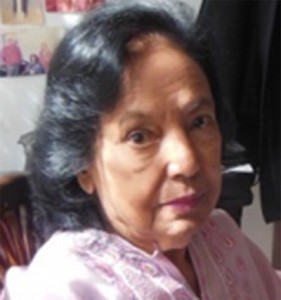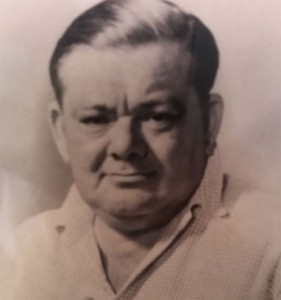Sunday Times 2
King of Hearts, Ace of Clubs
Murder is relative. There is murder, and then there is MURDER. The first is the kind that makes it into the news as a single-paragraph item in the daily police log, and may not get another media mention after that. The one-paragraph crime story of a fisherman knifing his wife’s nocturnal lover is a crime of passion that was murder yesterday, news today, and a forgotten incident tomorrow.
The second type of murder gets the big headline. It has mass-audience appeal and built-in longevity. It is front-page news from day one and goes on being news ever after, long after everyone concerned has permanently left the scene. The components of this kind of murder ensure the widest possible media coverage, unlimited speculation, talk and gossip, and periodical reviews. The potential to spark interest in the case from one generation to another is in the nature of this particular beast.

Happy encounter: Garfield Sobers and Mahadeva Sathasivam. Pic courtesy cricketique.files.wordpress.com
The first kind of murder involves nobodies, the second features somebodies.
The somebodies in the case under review are a husband and a wife from two elite families in the Colombo Tamil community. The husband, Mahadeva Sathasivam (1915-1977), was the island’s greatest cricketer ever, and his wife, Ananda Rajendra-Sathasivam (1916-1951), came from a distinguished family famous for their outstanding patriotism, integrity and capability. The husband was charged with the murder of his wife, by asphyxiation through manual strangulation. The domestic helper who was originally charged along with his master became Crown witness in what became the country’s most famous murder trial. The trial ran for 57 days, from March 23 to June 25, 1953.
To this day, no one knows what really happened at the Sathasivam residence at No. 7, St. Alban’s Place, Bambalapitiya on the morning of 9 October 1951. Mahadeva Sathasivam was found not guilty and was acquitted.
The audience for the Sathasivam drama subscribe to three theories: that the crime was carried out by the master, with the unwilling assistance of the servant boy in the house; that the master alone committed the crime, that the servant boy alone was the killer.

Maureen Seneviratne, PC: Met Justice Gratiaen at Yale University. Pic: SP
Consider the three versions as three transparencies depicting three separate murder scenes; projected on a screen simultaneously, the three combined slides show a tangle of forms and shapes and actions. The overlap of scenarios produces an image that is impenetrably grey and opaque. In the past 63 years, nothing has come up to relieve even slightly that greyness or clear that opacity. Not even the occasional stories we hear that the servant boy had finally made a confession, “made a clean breast of it” – to one policeman or another, in some district or other, over drinks, in this low dive or that – saying that he, and he alone, was the murderer. Cases of non-guilty parties, nonentities usually, seeking credit for crimes they never

US Attorney Marcia Clark: Fame impacts everybody
committed are not unknown in the world of crime. This is a behavioural phenomenon that someone trained in the psychology of crime could explain.
There is another reason to set the Sathasivam murder apart from other murders (committed on home ground), and that is the degree of evil. This is theological ground, but the lay public is entitled to its thoughts on the concept of evil. After the Sathasivam murder, the next best known, or most notorious, Colombo murder – murders, in fact – were committed in an Anglican vicarage by a man in the robes of a clergyman who was found guilty of two long-meditated killings – that of his lover’s husband and of his wife.
Evil is unquantifiable, but if one were asked to allocate points on a 1-to-10 scale of diabolical intent, one is tempted to give 10 out of 10 plus another 10 for the Anglican “priest’s” double-murder, and a 4 or a 5 for the Sathasivam murder. The evil in the Sathasivam murder is not of the same satanic order as the vicarage murders. The Sathasivam murder was an impulse killing that seems not to have had a long build-up.
If the guilty party in the Sathasivam case was the servant boy, then he murdered out of a desperation for money, the defence would have us believe; if it was the master of the house (assisted by the servant boy), then he acted out of frustration in marriage and love, and possibly some financial desperation, the Crown asserted.
The master of the house, according to a letter sent to the Police by the victim weeks before her death (the letter was suppressed at the trial), could be capable of “violence” and of “breaching the peace.” The letter made plain that there was some cause to “fear” Mr. Sathasivam.
Genius
As a sportsman, Mahadeva Sathasivam was blessed by the gods. A recent public poll conducted by a national newspaper ranked him as the country’s greatest cricketer ever. World-class players like Garfield Sobers and Frank Worrell said Satha was world-class, one of them. His adoring fans described Satha as a “genius” and an “artist,” whose performance on the pitch was pure “batting magic.” Satha was king of local cricket, king of hearts for cricket lovers.
Superlatives were also said of Mahadeva Sathasivam off the cricket field. People who knew him as a friend said he was the “nicest, most likable person you could meet.”

Noel Gratiaen, sportsman and club man. Pic courtesy of CR&FC
“There was not a wicked bone in Mahadeva Sathasivam,” said a member of a family famous in cricket that was close to the Sathasivams. “If you knew the man, you knew he was incapable of the crime he was charged with. Our family, to a man, was convinced of his innocence. He continued to be our dear friend after the trial. My family and his were on regular visiting terms. We would meet on sports and social occasions. We met frequently in England, after he moved there with his second wife and his children. When he returned to Ceylon, he continued to be one of our closest friends. When we were with him, the murder trial never crossed our minds.
“I have a personal reason for holding Mahadeva Sathasivam in great affection,” said the professional, who played cricket for his school. “It was the Big Match in 1968 or ’69. I was going out to bat when Sathasivam called out to me from the pavilion. I went up to him and he said the nicest thing. ‘Son, now go out and make sure you score a century before you come back!’ You could not help but like Mahadeva Sathasivam.”
“If you are so certain that Sathasivam was innocent,” we asked, “and that the boy alone did it – you pointed out that the boy on being arrested and interrogated by the Police had at first confessed that he did the killing – how come things went so badly for Sathasivam? How come the Attorney-General’s Department made the boy crown witness and put Sathasivam alone in the dock?”
“Sathasivam had enemies,” we were informed. “There were people who disliked him intensely. He was disliked for his talent, his arrogance, his popularity, his easy way with women. People jumped at the chance to fix him – highly placed people, including top brass enemies. Sathasivam was a swank. He irritated people. On the field, he made sure he cut a dash. He would wear his sleeves long and walk up to the wicket with a swagger. All this got to some people.”
“Got to people enough to want him hanged for a crime he may not have committed?” we asked.
“You never can tell how intensely someone can be disliked or hated, and how far people will go to nail someone.”
The club man
If Mahadeva Sathasivam was aware of enemies, and if this fact troubled him, he did not show it. Off the field, he had his legion of club buddies to turn to, have a drink with, and drown worries and annoyances.
Sathasivam was a prominent club man. His home turf was the Oval Sports Ground, or P. Saravanamuttu Stadium, of the Tamil Union Cricket and Athletics Club, in Colombo 8. Sathasivam was cricket captain of the Tamil Union Club from 1942 to ’45, and also in ’47 and ’48, and again, after his acquittal, from ’55 to ’57. His wife Ananda’s grandfather, Sir Ponnambalam Ramanathan, was president of the club from 1917 to 1931.
Mahadeva Sathasivam’s status and popularity meant that he was a welcome guest at any club, from the Tamil Union Club to the Ceylonese Rugby & Football Club, the Nondescripts Cricket Club and the Orient Club, as well as the Havelock and Nuwara Eliya Golf Clubs (he was a talented golfer too). One of the people in that privileged 1940s-50s fraternity of hearty, heavy-drinking sportsmen was Noel Gratiaen, who played for the Ceylonese Rugby & Football Club, at Longden Place. Noel Gratiaen was CR&FC Captain in 1932-33, and again in 1936-37.
That Noel Gratiaen and Mahadeva Sathasivam were club buddies and drinking companions was the subject of conversations critical of Justice Gratiaen agreeing to be presiding judge at the Sathasivam trial.
Strong opposition
Speaking from Australia, a son of a leading Ceylonese lawyer who was a Crown Counsel at the Magistrate’s Court hearing in the Sathasivam trial recalls talk of “strong opposition” to Judge Noel Gratiaen presiding at the trial. The opposition was from the judiciary and from within the Attorney-General’s Department.
“People were highly critical of Noel Gratiaen consenting to be the judge because he and Satha were friends. They went to the same clubs and they drank together. They were sports buddies – Gratiaen the formidable rugby player and Sathasivam the star batsman. Justice Gratiaen should have declined to be judge at the trial.”
Noel Gratiaen was a big man in every sense: a towering six feet four inches, weighing in at 250 pounds. In his book “A Murder in Ceylon,” Prof. Ravindra Fernando quotes a sports writer who wrote that “in the forward line, he [Noel Gratiaen] stood out, not merely because of his size, but because of his prowess. The tiny little rugger ball tucked under his arm, he would bulldoze his way to the touchline.”
It is as a hugely proportioned man who overwhelmed people with his size that Noel Gratiaen is remembered. This was confirmed by two people we talked to.
“Did you ever see Noel Gratiaen? He was enormous,” said David Jansze, son of Douglas Jansze, who succeeded Noel Gratiaen as Attorney-General in 1956. As a boy, David Jansze saw Justice Gratiaen on many occasions. “He filled the room with his presence. His person and his personality were big.”
A faithful retainer who has been with a well-known lawyer’s family for more than 60 years remembers Noel Gratiaen as a regular visitor. Asked to describe Justice Gratiaen, he stretched out both arms, suggesting the shoulder span of a giant.
Justice Gratiaen’s impressive physical presence would have had an effect on everyone in the courtroom, from spectators to lawyers and jurors. Seeing and hearing Justice Gratiaen deliver his famous summary in the Sathasivam case would have been an altogether different experience to reading Justice Gratiaen in transcript.
Noel Gratiaen was a large-hearted, sporty sort who relished the good life. He enjoyed eating and drinking. A distant relation of his recalls “Uncle Noel” dropping by on his way home after a busy day at Hulftsdorp for a cup of tea. More than the tea, Uncle Noel loved his late afternoon treat of fresh, crackly bread with a dish of beef curry made the Dutch Burgher way, spicy without the chilli.
Justice Gratiaen took great pride in his Dutch Burgher ancestry. In British times, you had an advantage if you looked European, and like many Dutch Burghers of his generation, Justice Gratiaen looked thoroughly European.
President’s Counsel Maureen Seneviratne, who expressed the greatest admiration for Justice Noel Gratiaen, has an endearing anecdote about the judge. In 1955, Ms. Seneviratne was a Fulbright scholar at Yale University. One day she was informed that a distinguished guest from her country would be hosted at a special dinner given by the Yale Law School faculty. Dressed in her finest sari, Ms. Seneviratne attended the dinner, where she was introduced to Justice Noel Gratiaen. Justice Gratiaen gave a speech, which was largely about his years at Oxford, where he had studied for a Bachelor of Arts degree, before moving on to law studies.
During the dinner, Yale academics told Justice Gratiaen that they had been hoping to hear about the legal practice in Ceylon, and not about Oxford. Unfazed, Justice Gratiaen smiled and declared that any questions about the Commonwealth of Nations Dominion of Ceylon may be addressed to the beautiful young lady in the sari sitting further down the table. Justice Gratiaen was satisfied with his role of projecting the European lineage of his country and its Europeanised legal history.
Hulftsdorp Hill
Father was of the retiring, sedentary type, not given to going about and socialising. This was largely the result of ill health. In his latter years, he was confined to his home much of the time. So people came to him, and with them the places they haunted. Hulftsdorp Hill and the world of lawyers in black coats came to him in the shape of solicitor Archibald Drieberg, a regular visitor and a close friend of the family from Father’s childhood days. Archie Drieberg was the brother-in-law of Douglas “Bud” Jansze, the Attorney General who succeeded Noel Gratiaen. He would tell us stories about lawyers and judges and court cases. He would have been just the person to talk to about the Sathasivam case, if only we had brought up the subject. If he did mention the case, we missed hearing about it.
What is remembered is a passing remark he made about the judge who presided at the trial: “Noel Gratiaen never sentenced a man to death,” Younger Brother recalls Archie Drieberg saying.
If that remark is true, and there is no cause to doubt it, we may have one good reason why Noel Gratiaen ended up in the judge’s seat in the Sathasivam trial. If, behind the scenes (and a lot went on behind the scenes in this particular case), it was “decided” that, come what may, the dashing sportsman and source of national pride Mahadeva Sathasivam had to be found not-guilty, then the unofficial machinery of the law may well have “engineered” the nomination of Justice Gratiaen.
There were strong reasons to nominate Noel Gratiaen. He had a reputation for fairness and impartiality, but even more important, as a Dutch Burgher, he would have been the preferred choice in a trial that had a celebrated Tamil in the dock and a peasant-class Sinhalese as Crown witness. A Tamil or Sinhalese judge would have been vulnerable to critics of the case.
Close friends
The Sathasivams were also close friends of a family that lived in our neighbourhood. As children, we were in and out of the big house and beautiful garden of the famous lawyer who lived there. He was a classmate of Father’s at Royal College in the ’30s. The lawyer’s widow was emphatic about Mahadeva Sathasivam’s innocence.
“If you knew Satha, you knew he was absolutely not guilty,” she said. “You couldn’t have met a nicer person. He was charming, he was gracious, a complete gentleman. He had style not only on the cricket field but also in person. He won hearts on and off the field. And he moved with such grace. You should have seen him dance at the Silver Fawn, the nightclub owned by Donovan Andree. When Satha glided across the ballroom floor, all eyes were on him. He would dance and drink till the early hours and then go out onto the cricket pitch and whack another century. He was amazing. Satha loved life. It was a joy to be in his company. I cannot imagine what suffering he would have gone through during his two years in remand prison. It must have broken his spirit.
“When he was arrested, a lot of people, jealous people, were gloating. The women, especially, were quite hard on him, because of his womanising ways.”
Mahadeva Sathasivam comes across as a pleasant, good-looking, pomaded charmer in a famous photograph with Garfield Sobers.
If Justice Noel Gratiaen was there in court for the express purpose of delivering Mahadeva Sathasivam from a terrible fate, he did admirably. While the summary of the case is lauded for its impartiality and fairness, you sense the judge taking full charge and making sure the jurors’verdict went in favour of the accused. The closing minutes of the summary show a judge in full control and, like a star rugby player with the ball in his hands, bulldozing his way to the touchline.
It is unlikely, in any event, that Mahadeva Sathasivam would have been found guilty. Not because he had the best choice of judge, the best of lawyers, and an English-speaking jury drawn from his own social background, but because of the fact that he was Mahadeva Sathasivam.
A correspondent writing from Australia described the Sathasivam case as this country’s “O. J. Simpson event.” A famous sportsman is charged with the murder of his wife, resulting in the country’s most famous trial.
Attorney Marcia Clark, the head prosecutor in the O. J. Simpson murder case, was asked by TIME Magazine earlier this year for a comment on the trial that had the US rivetted 20 years ago. “At the time,” she said, “I could not see the degree to which justice could be subverted by fame and the way fame impacts everybody: the judge, the lawyers, the witnesses.”
While justice may not have been subverted in the Sathasivam case, it is inconceivable that any court in this country would have found the famous cricketer guilty.
To be concluded next week, with a recent interview with the Crown witness in the 1953 Sathasivam trial.

